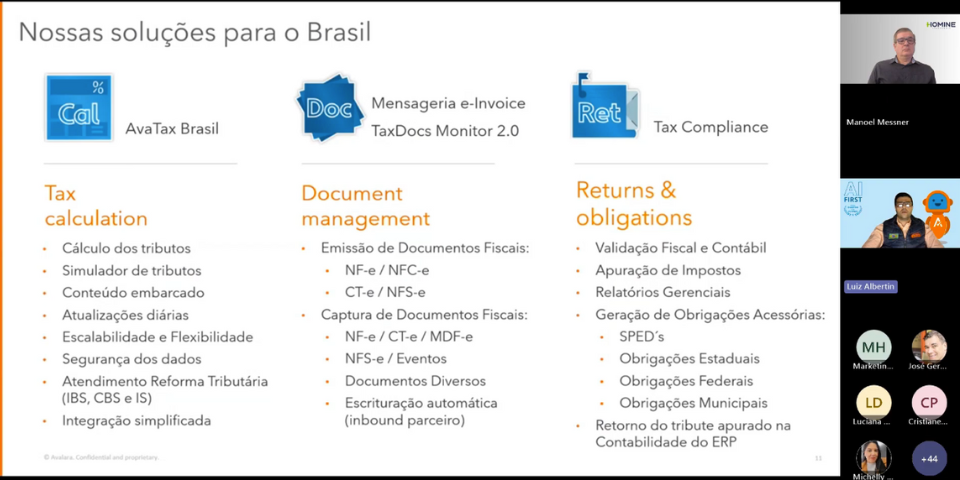
The difficult choice of VAT for purchasing documents in SAP: shall we solve this problem?
August 6, 2019
What changes in issuing your invoices with NT 2020.006?
March 29, 2021By Alfredo Menin, Co-founder and CTO of Homine
When one sees SAP's capillarity in Brazil today – practically “a religion” followed by most national companies –, no one imagines the challenges faced back in the beginning, in the 90s, for this software to come to the country and then become spread among national companies. Today, whenever I go to SAP events, which are invariably crowded, I remember that time.
The first hurdle was simply bringing the program to Brazil. I worked as an IT consultant at Origin – a company founded from a process of outsourcing carried out by Phillips in Brazil. We had already heard about this German software, SAP, which carried out the operational, logistical and financial management of companies.
Origin's president at the time assigned the company's Industry and Commerce cell to go after the program in Germany and bring it to the country. In 1992, a Brazilian team went there and returned with the CDs in their suitcase, on which the data from the R3 version of SAP was recorded. To install the program, we had to buy a computer with a CD reader – at that time, a novelty in the country.
The language barrier was the next challenge as the program was in the German language. Origin's Industry and Commerce cell, which I was part of, worked for months to translate the SAP lines into English. We consulted the dictionary all the time and finally completed the initial version of SAP R/3, in English, which went to the US market. So it was easier to translate from English to Portuguese.
Having overcome the language problem, we faced our biggest challenge: understanding how the program worked and adapting it to the country's fiscal and tax legislation – the localization work. We spent eight months “hidden” in the Origin office, in São Paulo, studying the software in depth – the programming, the database, the logistics and finance modules, in short, absolutely everything!
A German executive from SAP came to Brazil and gave us training on how the program works. However, she did not know all the modules. Because of this, German international consultants also came to Brazil and taught courses on what were, at that time, the basic SAP modules: SD-Sales, MM-Stock and Purchasing, PP-Production, FI-Finance and Legal Accounting, and CO-Controlling.
When we were more familiar with the new software, we started to carry out technical pre-sales, visiting Brazilian companies to understand how they calculated taxes. At the same time, a team from the Indústria e Comércio cell, with tax expertise, was set up to prepare, in English, a book containing the formulas for calculating Brazilian taxes. It was an intense learning process, which generated the “book of location”, with all fiscal and tax rules applicable in Brazil. And in 1993-94, an Origin team was assigned to travel to Germany with the book under their arm and worked for over a year within SAP.
The result was SAP R/3, a new and specific version for Brazil – the so-called “Brazilian localization”. It is important to point out that we were the 1st country to have a version of SAP adapted to its fiscal and tax reality in Latin America.
While the team was in Germany adapting the system to comply with Brazilian legislation, we were in a hurry to train IT consultants capable of implementing the software in companies. After all, what good would it be to have the Brazilian version of SAP, duly “localized”, if there was no one to implement it? Then was born the newhire academy, academy for training consultants, with SAP training that lasted 30 days, with classes in the morning, afternoon and evening! We trained more than 200 consultants during this period. And when the Brazilian version of the program arrived in the country, there was already qualified labor to implement it in the companies.
The start of sales was timid. German companies with subsidiaries in Brazil were the first to implement SAP here. In 1996, SAP do Brasil was created. The software has been improving year after year and there has been continuous growth since then, especially since it was already a “ready to use” program.bug of the millennium” – the concern that everyone had with possible failures in computational processes as a result of the turn of the millennium. The demand for SAP implementation projects was so high that, at one point, there was a lack of IT consultants in Brazil.
I feel privileged to have experienced the beginning of SAP in the country and to have learned so much from this whole process – the languages, the technical and functional part of the ERP, the training. All the sacrifice was worth it. Not to mention it's always nice to be part of history.




